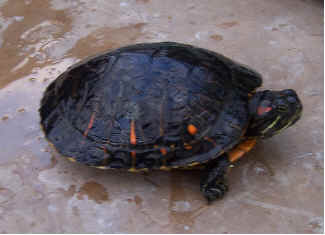

Red-Eared Sliders
Trachemys scripta elegans
Our sliders lead a peaceful life. We love to have you visit them but ask the following;
Rules of the Pond
1- Do not pick up or touch the turtles!
2- Do not throw anything in the pond. No stones, leaves, sticks, or little brothers!
3- Please no pushing or shoving to see the turtles.
On June 18, our large female Red-Eared Slider left the pond and we were lucky to see her while she was laying a clutch of eggs. She laid seven at that time and six more on July 6.
Her eggs finally began to hatch over Labor Day weekend. We have 8 that hatched with great success. The turtles are just beginning to eat so I think we are off to a good start. Come by to visit them.Some turtles live on land. Some live in water. Some live in the ocean. Some live in lakes and ponds. Where an animal lives is called its habitat.
The red eared sliders here like to live in slow moving water or lakes and ponds. They like water that is at least 2 feet deep. It is not usually found in temporary ponds. They were originally found in the Mississippi Valley but now are found over much of the South and west and in many countries around the world.
They live long and peaceful lives usually. This is partly because of the way they have evolved over millions of years. They have a shell that protects them from many predators. Even their skin is tough. This helps protects them from a number of predators. Their biggest natural danger is from disease.
Their feet have become very good tools. They are webbed for moving them through the water. The feet also have claws which help digging into mud and pulling apart food. The claws also help them to pull themselves up on the logs and stones that they like to sit on and bask in the sun. Sitting in the sun like that helps them get warm and, more important, it helps kill germs and disease organisms that might collect on their bodies. They have very poor hearing but are very sensitive to vibrations. When they think there is danger, they slide quickly into the water. That is where they get part of their name- sliders.
The other part of their name comes from the red or orange stripe or ear that runs on either side of their head. Sometimes this can fade as the turtles grow older. They also have yellow stripes that run through their green skin. The turtles carapace or shell is usually greenish or brownish with dark stripes or bands running along it. The underside or plastron is yellow with dark blotches in each section or plastron.
The red-eared slider is omnivorous. That means they eat plants and meat. Young turtles eat more meat, like bugs, fish, worms, and such. As the turtles grow older, they switch to finding more plants for their food and less meat.
The turtles can make good pets but there is a lot of work to keeping them. First, you have to find the turtles. They are not sold legally in New Jersey anymore because of the threat of disease, such as salmonella. They are available in other states and from mail order companies. When you do find one, you must make sure it is from a dealer who can show that they have not been caught from the wild. Please do not catch any turtles in the wild to use as pets. Enjoy them in their natural setting and purchase your turtles from a reputable dealer. When you get your turtle, you may need a permit to keep them. This comes from the Division of Fish and Wildlife in New Jersey.
Your turtle will need a good size area to swim in and this water must be kept clean, either by using a filter or by changing. They also need an area to bask on in the sun. This can be a stone or log. You must give them a healthy diet. They need a mix of meats( shrimp, cooked chicken, worms, and others) and plant matter( Fruits, like watermelon and cantaloupe, and vegetables, like lettuce, carrots, and spinach). They can also eat some of the turtle food found in pet stores. Food that they do not eat must be removed from the water immediately.
With good care, your turtle can live very long. They can live up to 30 years. So getting one as a pet is a long term commitment. What do you do if you grow tired of your turtle? Do not release it into the wild. This can spread disease and hurt native turtle populations as well as other animals. Find someone who may take care of it or you can get in touch with a group like Turtle Homes. You can find their name attached. They specialize in finding homes for pet turtles. They can be a source of turtles as well. They may be contacted if you are willing to adopt a turtle.
It is important to remember not to release the sliders into the wild. They have become present in many areas of the world, to the point of being called one of the 100 "World’s Worst" invaders by the ISSG (Invasive Species Specialist Group).
New Jersey Division of Fish and Wildlife
P.O. Box 400
Trenton, NJ 08625-0400
We bring our sliders to local schools to help children learn about them. We try to do this during our quieter season- January- February. The talk works best for 3rd to 4th graders but we can be pretty adaptable. E-mail for more information- Ramberg178@aol.com